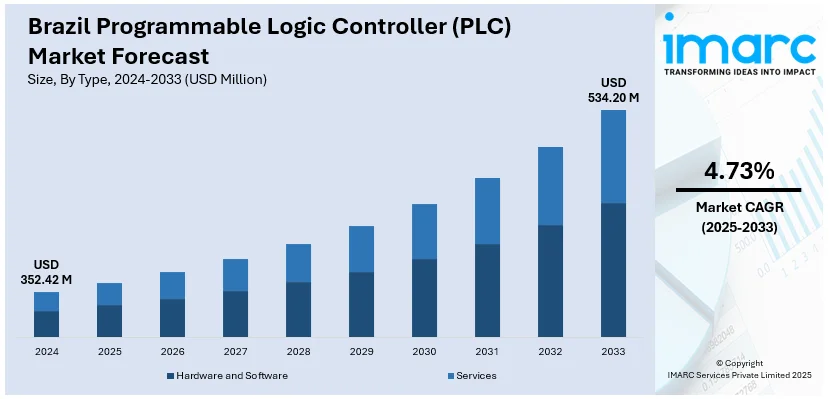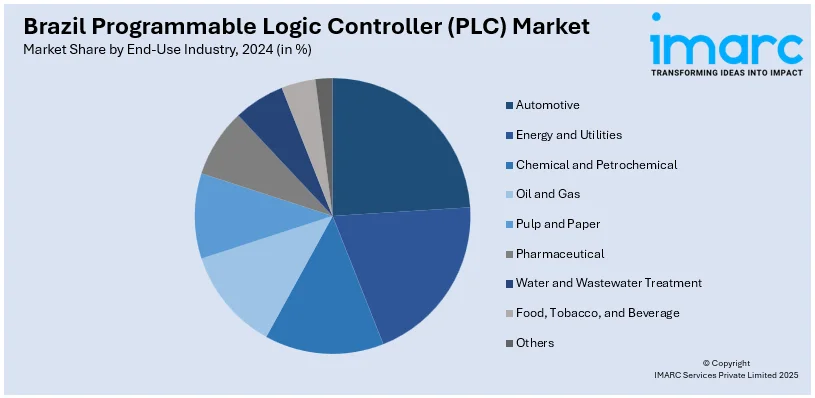
Brazil Programmable Logic Controller (PLC) Market Size, Share, Trends and Forecast by Type, End-Use Industry, and Region, 2025-2033
Brazil Programmable Logic Controller (PLC) Market Overview:
The Brazil programmable logic controller (PLC) market size reached USD 352.42 Million in 2024. Looking forward, IMARC Group expects the market to reach USD 534.20 Million by 2033, exhibiting a growth rate (CAGR) of 4.73% during 2025-2033. The rising use of wastewater systems to optimize pumping, filtration, and treatment processes, improving efficiency, compliance, and reliability is bolstering the market growth in Brazil. In energy, they stabilize variable renewables, support remote monitoring, and reduce downtime, contributing to the expansion of the Brazil programmable logic controller (PLC) market share.
|
Report Attribute
|
Key Statistics
|
|---|---|
|
Base Year
|
2024
|
|
Forecast Years
|
2025-2033
|
|
Historical Years
|
2019-2024
|
| Market Size in 2024 | USD 352.42 Million |
| Market Forecast in 2033 | USD 534.20 Million |
| Market Growth Rate 2025-2033 | 4.73% |
Brazil Programmable Logic Controller (PLC) Market Trends:
Water and Wastewater Management Modernization
The growing population in Brazil is driving the need for improved water supply and sanitation facilities. Municipalities and private operators are progressively utilizing PLCs to enhance essential elements of water systems like pumping stations, filtration units, and wastewater treatment plants. PLCs facilitate ongoing, immediate observation of essential factors like flow rates, chemical dosing, and pressure levels, leading to decreased waste and energy usage while enhancing service dependability. With investments from both government and private sectors in upgrading water infrastructure, automation is becoming a key element in ensuring sustainable operations. A significant instance of these investments is the 2025 collaboration between Veolia and Brazil, resulting in the establishment of the Águas de Reúso de Vitória Water Reclamation Station. This state-of-the-art wastewater recycling plant is engineered to handle 450 liters of wastewater every second, with a remarkable 85% of the treated water reused for industrial purposes. This initiative marks a substantial advancement in tackling water shortages and enhancing sustainability in Brazil’s water management framework. PLCs play a crucial role in meeting stricter environmental regulations by ensuring that treated water complies with the necessary quality standards prior to being released into natural water bodies. Moreover, as water management issues intensify, PLC-driven systems are becoming more important for enhancing the effective functioning of urban and industrial water systems.

To get more information on this market, Request Sample
Growth of Renewable Energy Integration
Brazil’s energy sector is undergoing a notable transformation, with increasing investments in wind, solar, and biomass projects complementing its long-standing reliance on hydroelectric power. PLCs play a crucial role in this transition by offering the precise monitoring, synchronization, and fault detection necessary for ensuring stability in power systems marked by fluctuating generation. Through load balancing and facilitating remote diagnostics, PLCs guarantee that renewable energy installations function effectively and dependably across widely spread locations. Their function becomes increasingly vital as operators aim to minimize downtime and enhance output in decentralized energy systems. The government's dedication to cleaner energy sources boosts this demand, placing PLCs at the core of Brazil’s renewable strategy. In 2024, ArcelorMittal Brazil signed contracts for two solar energy projects totaling 465MW capacity, which will meet 14% of its electricity needs. The first project, a 200MW solar plant in Bahia, will be developed alongside an existing wind project, while the second, a 265MW solar plant in Minas Gerais, will be completed in 2025. Such efforts highlight the growing need for PLC-driven automation in renewable solutions for offering sophisticated control systems in meeting sustainability goals and providing a reliable energy supply for extensive operations in Brazil.
Brazil Programmable Logic Controller (PLC) Market Segmentation:
IMARC Group provides an analysis of the key trends in each segment of the market, along with forecasts at the country and regional levels for 2025-2033. Our report has categorized the market based on type and end-use industry.
Type Insights:
- Hardware and Software
- Large PLC
- Nano PLC
- Small PLC
- Medium PLC
- Others
- Services
The report has provided a detailed breakup and analysis of the market based on the type. This includes hardware and software (large PLC, nano PLC, small PLC, medium PLC, and others) and services.
End-Use Industry Insights:

- Automotive
- Energy and Utilities
- Chemical and Petrochemical
- Oil and Gas
- Pulp and Paper
- Pharmaceutical
- Water and Wastewater Treatment
- Food, Tobacco, and Beverage
- Others
A detailed breakup and analysis of the market based on the end-use industry have also been provided in the report. This includes automotive, energy and utilities, chemical and petrochemical, oil and gas, pulp and paper, pharmaceutical, water and wastewater treatment, food, tobacco, and beverage, and others.
Regional Insights:
- Southeast
- South
- Northeast
- North
- Central-West
The report has also provided a comprehensive analysis of all the major regional markets, which include Southeast, South, Northeast, North, and Central-West.
Competitive Landscape:
The market research report has also provided a comprehensive analysis of the competitive landscape. Competitive analysis such as market structure, key player positioning, top winning strategies, competitive dashboard, and company evaluation quadrant has been covered in the report. Also, detailed profiles of all major companies have been provided.
Brazil Programmable Logic Controller (PLC) Market News:
- In February 2024, WEG launched the PLC410 programmable logic controller, marking a significant step in industrial automation. The PLC410, aimed at OEMs in industries like pulp, paper, and pharmaceuticals, offered advanced programming with CODESYS® and supported Industry 4.0 protocols. It enhanced flexibility with 208 IOs and is WEG IoT Ready, providing high performance and cost-effectiveness.
Brazil Programmable Logic Controller (PLC) Market Report Coverage:
| Report Features | Details |
|---|---|
| Base Year of the Analysis | 2024 |
| Historical Period | 2019-2024 |
| Forecast Period | 2025-2033 |
| Units | Million USD |
| Scope of the Report |
Exploration of Historical Trends and Market Outlook, Industry Catalysts and Challenges, Segment-Wise Historical and Future Market Assessment:
|
| Types Covered |
|
| End-Use Industries Covered | Automotive, Energy and Utilities, Chemical and Petrochemical, Oil and Gas, Pulp and Paper, Pharmaceutical, Water and Wastewater Treatment, Food, Tobacco, and Beverage, Others |
| Regions Covered | Southeast, South, Northeast, North, Central-West |
| Customization Scope | 10% Free Customization |
| Post-Sale Analyst Support | 10-12 Weeks |
| Delivery Format | PDF and Excel through Email (We can also provide the editable version of the report in PPT/Word format on special request) |
Key Questions Answered in This Report:
- How has the Brazil programmable logic controller (PLC) market performed so far and how will it perform in the coming years?
- What is the breakup of the Brazil programmable logic controller (PLC) market on the basis of type?
- What is the breakup of the Brazil programmable logic controller (PLC) market on the basis of end-use industry?
- What is the breakup of the Brazil programmable logic controller (PLC) market on the basis of region?
- What are the various stages in the value chain of the Brazil programmable logic controller (PLC) market?
- What are the key driving factors and challenges in the Brazil programmable logic controller (PLC) market?
- What is the structure of the Brazil programmable logic controller (PLC) market and who are the key players?
- What is the degree of competition in the Brazil programmable logic controller (PLC) market?
Key Benefits for Stakeholders:
- IMARC’s industry report offers a comprehensive quantitative analysis of various market segments, historical and current market trends, market forecasts, and dynamics of the Brazil programmable logic controller (PLC) market from 2019-2033.
- The research report provides the latest information on the market drivers, challenges, and opportunities in the Brazil programmable logic controller (PLC) market.
- Porter's five forces analysis assist stakeholders in assessing the impact of new entrants, competitive rivalry, supplier power, buyer power, and the threat of substitution. It helps stakeholders to analyze the level of competition within the Brazil programmable logic controller (PLC) industry and its attractiveness.
- Competitive landscape allows stakeholders to understand their competitive environment and provides an insight into the current positions of key players in the market.
Need more help?
- Speak to our experienced analysts for insights on the current market scenarios.
- Include additional segments and countries to customize the report as per your requirement.
- Gain an unparalleled competitive advantage in your domain by understanding how to utilize the report and positively impacting your operations and revenue.
- For further assistance, please connect with our analysts.
 Request Customization
Request Customization
 Speak to an Analyst
Speak to an Analyst
 Request Brochure
Request Brochure
 Inquire Before Buying
Inquire Before Buying




.webp)




.webp)












